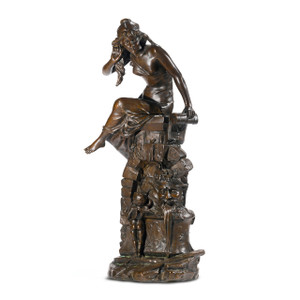
Japonisme Bronze Jardinière att. to Édouard-Alexandre Dammouse for Haviland & Co
Japonisme stoneware and bronze jardinière attributed to Édouard-Alexandre Dammouse for Haviland & Co, with bronze mounts attributed to F . Barbedienne.
Based on the principles of the British Arts and Crafts movement, Art Nouveau artists sought to reform the decorative arts by emphasizing uniqueness and a return to craftsmanship. Artist-potters found inspiration in Asian ceramics, particularly Japanese stoneware (a hard, dense type of pottery), which was shown in 1878 at the Exposition Universelle in Paris, as well as in the forms, glazes, and techniques of Chinese porcelain and pottery. They also looked to European traditions such as the rustic salt-glazed stoneware of the sixteenth and seventeenth centuries and Gothic sculpture and architecture. In the process they created works of ceramic art that were entirely modern and new.
Origin: French, Paris
Date: Late 19th-century, Circa 1880's
Dimensions: 16in H x 17in W x 13in D
Produced by Haviland & Company - stamped with their H & Co rosary stamp on the bottom
Founded in 1864, Haviland & Co. consistently pushed boundaries in their industry under the leadership of Charles Haviland (1839-1921) and initiated a revolution in porcelain decoration in the 1870s thanks to artistic director Félix Bracquemond’s use of chromolithography on ceramics. Bracquemond also initiated collaborations with various artists including the brothers Edouard-Alexandre and Albert-Louis Dammouse, Felix Lafond, and Edouard Lindeneher, a wise decision that would bear even more impressive artistic fruit the following decade. In 1874, Haviland purchased the secrets to renowned ceramist Ernest Chaplet’s recently developed barbotine technique and, the following year, hired Chaplet to further develop the ware at the company’s experimental studio in Auteuil.
Chaplet’s reputation at Haviland was such that, when high production costs forced the company to close the Auteuil studio in 1881, he convinced the firm to open another atelier on the Rue Blomet, Vaugirard in Paris. For the next several years, Chaplet oversaw the creation of a wide variety of wares. He was an adherent to Arts and Crafts philosophies and believed strongly in fostering a creative atmosphere in which a single artisan is responsible for both the design and execution of an object. Similar to Bracquemond before him, Chaplet collaborated with about 20 artists, chief among them the Dammouse brothers and Ringel d'Illzach, with whom he produced stoneware and experimental porcelain. The resulting vases and sculptures ranged from red-brown stoneware with incised Japonesque decoration, colored slips, enamels, and gilding, to oxblood-glazed porcelain vases and figurines.
Beyond his leadership and collaborative efforts, it was at the Vaugirard studio that Chaplet—with chemist Lebrun de Rabot—finally succeeded in reproducing the elusive sang-de-boeuf (oxblood) glaze he had seen on medieval Chinese ceramics. In 1886, economic difficulties forced Haviland to cease production at all locations except his Limoges factory. Chaplet acquired the Rue Blomet studio, which he then ceded in 1897 to fellow ceramist extraordinaire, Auguste Delaherche. Chaplet went on to make his own, indelible mark on the industry, but his tenure at Haviland’s experimental ateliers remain some of the most influential and stylistically diverse in the history of Western ceramics.

















